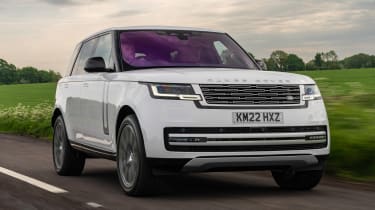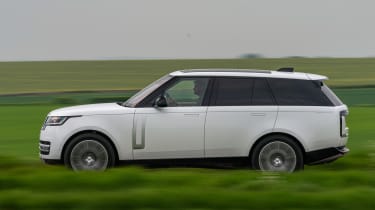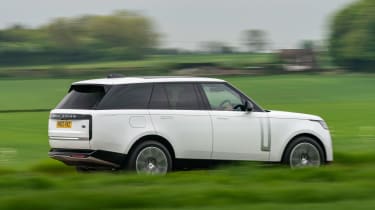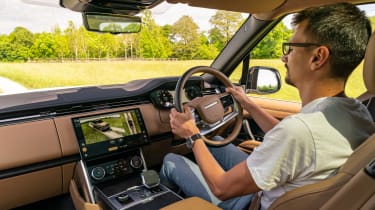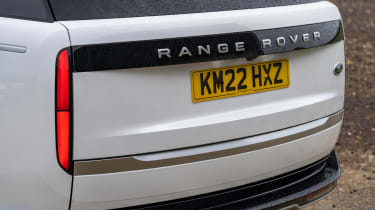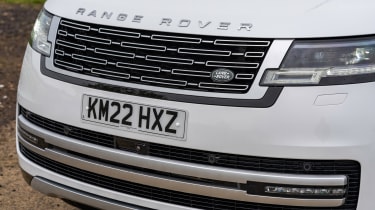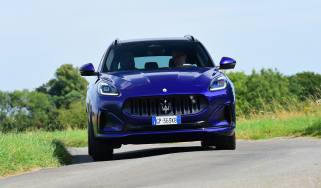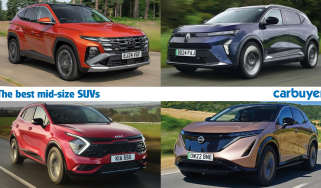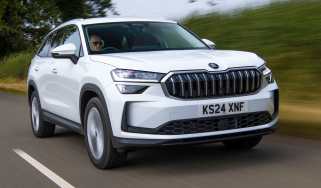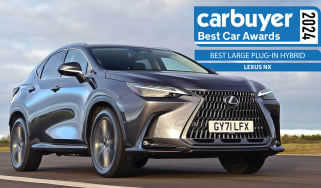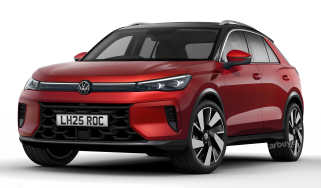Range Rover review – comfy and luxurious, but not perfect
“The Range Rover is an outstanding all-rounder that blends luxury, practicality and go-anywhere ability”
Pros
- Impeccable luxury
- Spread of ability
- Seven-seat versions available
Cons
- No electric version at launch
- Six-figure prices
- Poor owner satisfaction
Verdict – is the Range Rover a good car?
The latest Range Rover is more synonymous with refined, impeccable luxury than ever before and we rate it as one of the best luxury SUVs on sale. With varied powertrains on offer including mild-hybrid diesel and plug-in hybrid versions, the Range Rover has plenty of bases covered – a forthcoming all-electric model will broaden the range even further. A stretched seven-seater option makes the Range Rover even more versatile for those seeking elevated VIP travel. That said, even the mild hybrids will be relatively thirsty and costly to run, and it’s an expensive car to buy in the first place. Reliability issues have been a thorn in Range Rover’s side for a while now, but the brand hopes to combat this with a huge investment in its manufacturing plant.
Range Rover models, specs and alternatives
The introduction of a new Range Rover generation is a special occasion. After all, it’s been more than half a century since the first one turned its wheels, and this latest version is only the fifth iteration since then.
At first, it appears Land Rover’s designers photocopied the styling of the last car and called it a day, but look closer and a host of changes become apparent. The windows fit flush, and some of the creases and design fripperies from before have been tidied up. That’s the overarching theme of the styling – it’s been simplified and honed and looks more effortlessly modern as a result. Perhaps the best indicator of its success is that it makes the previous generation instantly look dated.
The light clusters are far more technologically advanced; many of the rear lights are hidden when they’re not on. Fit and finish have improved both inside and out; Land Rover is looking to improve quality and reliability with the latest Range Rover, as well as making it more desirable.
More reviews
Inside, the Range Rover features more technology than before, giving it an arsenal of gadgets that few cars can match. Material quality is excellent, and you get a wide range of upholstery options including leather and sustainable Kvadrat and Ultrafabrics choices – these are textiles and a mix of fake leather and suede respectively.
Land Rover’s latest-generation infotainment software is fitted into a larger touchscreen, which is the control point for many of the car’s extensive features. There are digital dials, too, and new touch-sensitive panels on the steering wheel. The driving position is imperious; refinement is top-notch.
A dizzyingly comprehensive range of engines is available, from mild-hybrid diesel engines to a plug-in hybrid that promises the same electric range as some small EVs. A fully electric Range Rover is coming in 2024 or – if that’s not your thing – there’s a meaty V8 petrol engine in the Range Rover SV too.
The Range Rover now starts from around £104,000, so it needs to feel impressively luxurious and technologically advanced. The good news is it does, and feels worthy of that sky-high price tag. It’s noticeably less expensive than the Bentley Bentayga, and isn’t any less opulent.
MPG, running costs & CO2
The headline figure is that the plug-in hybrid Range Rover will manage up to 73 miles of range on electric power alone. That’s pretty astonishing compared to almost any other plug-in hybrid luxury SUV on sale right now, and enables an official economy figure of up to 375.7mpg. It’ll be the obvious choice for business drivers, with CO2 emissions from 17g/km putting it in a surprisingly low Benefit-in-Kind tax band. Even if you go for the long wheelbase version in Autobiography trim this only climbs to 19g/km.
Diesel engines feature mild-hybrid technology to reduce emissions, although it has little impact on a 2.5-tonne car. Both the D300 and D350 manage up to 38.3mpg with CO2 from just over 190g/km, which certainly won’t appeal to the company car crowd, but aren’t too outlandish for private buyers after a big, luxury 4x4. It also beats some rivals, with the Mercedes GLS 450 d lagging behind with just 32.1mpg and 231g/km.
During our test, we averaged 32.4mpg in the D350, which isn’t anything to get too excited about. However, when compared with the 20.2mpg of the Bentley Bentayga we achieved on the same route, it would equate to around £2,700 less per year in fuel cost if you cover 20,000 miles annually.
Petrol engines have been virtually phased out, with only the high-performance Range Rover SV coming in P615 guise. This might be a mild-hybrid, but it’s aimed at money-no-object buyers who won’t sniff at its 24.2mpg economy figure and 264g/km emissions.
Road tax costs over £500 until the car is six years old, while insurance, maintenance and parts will all be considerable. But that’s to be expected from a car like the Range Rover, and most buyers won’t be fazed by its high running costs.
Engines, drive & performance
Range Rover drivers can choose from mild-hybrid diesel engines, plus plug-in hybrid versions and a sole high-performance petrol. For the first time, a fully electric version will even be available, although that’s due to launch in late 2024. Diesel may be deeply unfashionable these days but the 3.0-litre six-cylinder engine, with either 296bhp or 346bhp, is the ideal accompaniment to the Range Rover if you’re a private buyer.
We drove the more powerful diesel, which comes with a huge amount of low-down power. That reserve of torque makes for effortless overtaking and allows urgent acceleration when the mood takes you. It’s not a car you’ll want to drive quickly for the fun of it, but it can easily creep over the speed limit if you aren’t paying close attention. The diesel also appeals for its ability to travel huge distances on a single tank of fuel, and it’s clear that a lot of work has been done to prevent the engine from disturbing the occupants inside. Yes, the noise rises slightly if you pin the throttle, but most of the time it’s barely noticeable.
A petrol engine of the same size and with the same number of cylinders was previously available with 396bhp, but as of mid-2024 this is no longer being offered. Both the diesel and petrol get from 0-62mph in around six seconds but it’s the diesel that feels slightly quicker thanks to its impressive grunt. Refinement was a little better in the petrol – it’s almost silent – but the difference isn’t that great.
Above that is a 4.4-litre V8 petrol, with 607bhp and a 0-62mph time of 4.3 seconds. The engine is far more audible here when you want it to be – but that’s a big part of the appeal.
Our main gripe with the way the new Range Rover drives is its eight-speed ZF automatic gearbox. When cruising around at slow speeds, gear changes are silky smooth and quickly fade into the background. Under acceleration, however, the shifts can be surprisingly harsh, disturbing the car’s otherwise unflappable manner.
Despite the smallest wheel option being a huge 21 inches in diameter (HGV-rivalling 23-inch alloys are also available), the Range Rover has a well-judged ride. Apart from the odd unwelcome thud from larger bumps at low speeds, it’s one of the most comfortable cars around to travel in. Aladdin’s magic carpet was referenced by the Land Rover team, and that’s not as ridiculous as it might sound – the effect achieved by active electronically controlled air suspension and cameras reading the road ahead is impressive.
You may be surprised to hear that the latest Range Rover is uncharacteristically manoeuvrable around urban areas, where many models will inevitably spend most of their time. Thanks to the inclusion of rear-wheel-steering, the hulking SUV can turn its rear wheels in the opposite direction of those in the front to provide a turning circle of just under 11 metres – the same as the much smaller Range Rover Velar.
Of course, if you do decide to venture outside the city and off the beaten track, the technology on board extends to make the Range Rover as good off-road as we’ve come to expect. The wealth of features at your fingertips means the car will essentially navigate over the toughest terrain by itself. Whether on or off-road, you get the impression that the car can take anything in its stride. Consequently, after a full day’s driving, we left the car feeling as refreshed as when we started.
Interior & comfort
Like the exterior, the interior of the new Range Rover feels familiar but the overall effect is slicker with less fussy detailing. The air vents are better integrated, and there’s a little less chrome trim.
Sitting pride of place is a 13.1-inch tablet-like touchscreen, which looks a bit more restrained than the bigger touchscreens in cars like the Tesla Model X. It’s placed quite low; we wonder if Land Rover could have gone bigger – but maybe that’ll come in a later update. While the haptic feedback isn’t particularly intuitive, the screen is pleasing to use – and we’re glad to see that physical climate dials have been retained.
The driving position is just as commanding as before, and those large windows give you a fantastic field of vision. It makes you feel special, which is why the Range Rover has become the default choice for many buyers. It also benefits from the digital rear-view mirror originally designed for the Defender with its tailgate-mounted spare wheel. It still proves handy here, even working well to reduce glare from following cars at night.
It’s not entirely perfect, though. The gearlever is a little awkward and its sensitivity makes it hard to find neutral, while some of the plastic bits by the windows aren’t up to the quality of the rest of the interior. Really, though, these are minor gripes with what is otherwise an opulent cabin.
Standard features include high-tech LED headlights, a fixed glass roof, electric heated seats front and rear, air suspension, adaptive cruise control, wireless phone charging, a surround-view camera and all-wheel steering. Some of the extra kit fitted to HSE models include upgraded headlights, bigger wheels, ventilated seats, a head-up display and a Meridian surround sound system.
Above that are the Autobiography and SV specifications. You can customise the car to your heart’s content, and even call upon the services of Land Rover’s bespoke department if you so wish.
Road and wind noise is well suppressed, although the largest 22-inch alloy wheels can allow some thumps into the interior - even if the air suspension does a good job of keeping things comfortable.
Practicality & boot space
The wheelbase (the distance between the front and rear wheels) is longer than the previous Range Rover’s, which improves legroom. You can order a three-seat rear bench or two ‘Executive Class’ seats – the latter is reserved for high-end models, and includes a powered table that rises out of the centre console. There’s a fridge available, too. Interior storage impresses, thanks not only to deep door bins and a centre console with four individual areas, but also twin gloveboxes.
You’ll need to specify a long-wheelbase variant if you want to order seven seats. Those in the rearmost seats might find their knees a bit higher than is optimally comfortable, as the seats are mounted quite low, but there’s a good amount of knee and headroom. All seats are powered, and the third row folds away into the boot floor at the touch of a button.
The lower portion of the tailgate is a little smaller than the one fitted to its predecessor, which makes it a little easier to reach the back of the boot, but it’s still awkward. Incidentally, the Range Rover offers an 818-litre boot in five-seat mode, but that’s likely to be measured to the roofline rather than the parcel shelf – which is what most manufacturers do.
There are a few party tricks too, including the option to press a button to lower the rear suspension, making it easier to lift heavy or awkward items into the boot. The lower tailgate also makes a handy place to sit while out and about, and Land Rover has capitalised on this, adding a pop-up backrest and even a place to put your drinks.
Reliability & safety
Land Rover’s record for reliability is concerning, with 42% of buyers reporting faults with their cars in the first year of ownership, a finding that contributed to the British brand placing 14th out of 32 brands in our 2023 Driver Power survey. It came last for reliability overall, along with value for money, while its scores for servicing costs also weren’t great. Yet, owners tend to have a polarised relationship with their cars, putting their Land Rover models fourth for exterior design, along with high scores for comfort and practicality.
Perhaps Land Rover is turning a corner, though; it has recently put huge investment into its Solihull plant to try and overcome its lacklustre quality reputation, and our test cars felt extremely well-built. With the sheer amount of technology on the Range Rover – bolstered by new features like all-wheel steering – there’s potentially a lot to go wrong, but hopefully owners won’t find that to be the case.
The Range Rover was crash-tested by Euro NCAP in late 2022, and a strong chassis and plenty of driver assistance technology meant it proved itself adept at keeping its occupants safe and out of harm’s way. It achieved a five-star score, managing more than 80% in the Adult Occupant, Child Occupant and Safety Assist categories.

